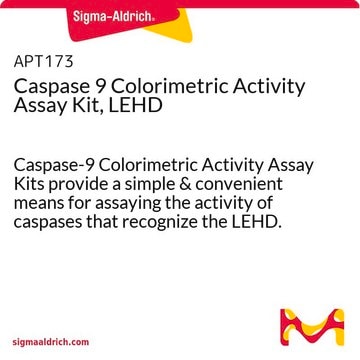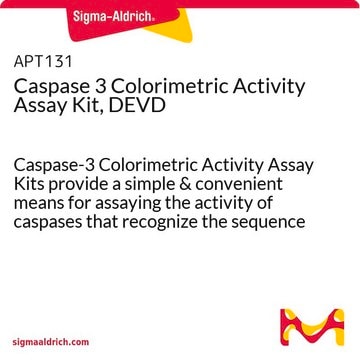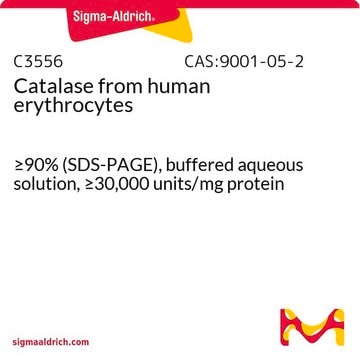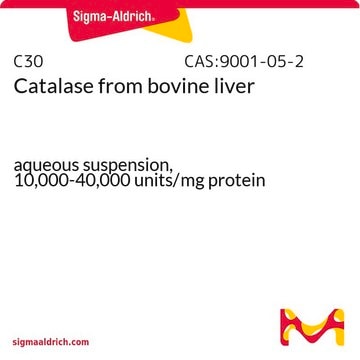APT171
Caspase 8 Colorimetric Activity Assay Kit, IETD
Caspase-8 Colorimetric Activity Assay Kits provide a simple & convenient means for assaying the activity of caspases that recognize the sequence IETD.
Synonym(s):
FLICE
Sign Into View Organizational & Contract Pricing
All Photos(1)
About This Item
UNSPSC Code:
12161503
eCl@ss:
32161000
Recommended Products
species reactivity (predicted by homology)
mammals
manufacturer/tradename
Chemicon®
technique(s)
activity assay: suitable
NCBI accession no.
UniProt accession no.
detection method
colorimetric
shipped in
dry ice
General description
Activation of ICE-family proteases/caspases initiates apoptosis in mammalian cells. Chemicon′s Caspase-8 Colorimetric Activity Assay Kits provide a simple and convenient means for assaying the activity of caspases that recognize the sequence IETD. The assay is based on spectophotometric detection of the chromophore p-nitroaniline (pNA) after cleavage from the labeled substrate IETD-pNA. The free pNA can be quantified using a spectrophotometer or a microtiter plate reader at 405 nm. Comparison of the absorbance of pNA from an apoptotic sample with an uninduced control allows determination of the fold increase in caspase-8 activity.
Application
Caspase-8 Colorimetric Activity Assay Kits provide a simple & convenient means for assaying the activity of caspases that recognize the sequence IETD.
Research Category
Apoptosis & Cancer
Apoptosis & Cancer
Components
5X Cell Lysis Buffer (Part No. 90065): 5 mL
5X Assay Buffer (Part No. 90066): 10 mL
Caspase-8 Substrate (Ac-IETD-pNA) (Part No. 90082): 1 mL of 2.5 mg/mL solution
Caspase-8 Inhibitor (Ac-IETD-CHO) (Part No. 90086): 50 μL of 100 μM (0.05 mg/mL) in DMSO
pNA Standard (Part No. 90085): 250 μL of 10 mM in DMSO
5X Assay Buffer (Part No. 90066): 10 mL
Caspase-8 Substrate (Ac-IETD-pNA) (Part No. 90082): 1 mL of 2.5 mg/mL solution
Caspase-8 Inhibitor (Ac-IETD-CHO) (Part No. 90086): 50 μL of 100 μM (0.05 mg/mL) in DMSO
pNA Standard (Part No. 90085): 250 μL of 10 mM in DMSO
Storage and Stability
Store kit materials at -20°C up to their expiration date.
Special Precautions:
· After thawing reagents, use immediately or aliquot and freeze at -20oC for longer storage. Avoid repeated freeze/thaw cycles.
· The Caspase-8 substrate and pNA standard are especially light sensitive. Maintain these reagents in amber or covered containers.
Special Precautions:
· After thawing reagents, use immediately or aliquot and freeze at -20oC for longer storage. Avoid repeated freeze/thaw cycles.
· The Caspase-8 substrate and pNA standard are especially light sensitive. Maintain these reagents in amber or covered containers.
Legal Information
CHEMICON is a registered trademark of Merck KGaA, Darmstadt, Germany
Disclaimer
Unless otherwise stated in our catalog or other company documentation accompanying the product(s), our products are intended for research use only and are not to be used for any other purpose, which includes but is not limited to, unauthorized commercial uses, in vitro diagnostic uses, ex vivo or in vivo therapeutic uses or any type of consumption or application to humans or animals.
Storage Class Code
10 - Combustible liquids
Certificates of Analysis (COA)
Search for Certificates of Analysis (COA) by entering the products Lot/Batch Number. Lot and Batch Numbers can be found on a product’s label following the words ‘Lot’ or ‘Batch’.
Already Own This Product?
Find documentation for the products that you have recently purchased in the Document Library.
Svetlana P Chapoval et al.
Journal of immunology (Baltimore, Md. : 1950), 179(10), 7030-7041 (2007-11-06)
IL-13 is a major Th2 cytokine that is capable of inducing inflammation, excessive mucus production, airway hyperresponsiveness, alveolar remodeling, and fibrosis in the murine lung. Although IL-13 through its binding to IL-4Ralpha/IL-13Ralpha1 uses the canonical STAT6-signaling pathway to mediate these
Annalisa Marcuzzi et al.
International journal of developmental neuroscience : the official journal of the International Society for Developmental Neuroscience, 30(6), 451-456 (2012-07-05)
Mevalonic aciduria (MA), the most severe form of mevalonate kinase deficiency (MKD), is still an orphan drug disease and the pathogenetic mechanisms underlying neuronal dysfunction is still poorly understood. In our study we have investigated the apoptotic mechanism mediated by
Toru Nakazawa et al.
Investigative ophthalmology & visual science, 52(3), 1384-1391 (2011-03-16)
Photoreceptor degeneration is a major cause of visual loss in various retinal diseases, including retinal detachment (RD) and neovascular AMD, but the underlying mechanisms remain elusive. In this study, the role of TNFα in RD-induced photoreceptor degeneration was investigated. RD
Zehra Betül Kingir et al.
Ulusal travma ve acil cerrahi dergisi = Turkish journal of trauma & emergency surgery : TJTES, 25(3), 213-221 (2019-05-29)
The aim of this study was to evaluate the possible protective effects of dapagliflozin in an experimental sepsis model in rats. Saline (1 mL/kg, p.o.) or dapagliflozin (10 mg/kg, p.o.) was administered to Sprague-Dawley rats for 5 days prior to
Luigi Leanza et al.
EMBO molecular medicine, 4(7), 577-593 (2012-04-13)
Overcoming the resistance of tumours to chemotherapy, often due to downregulation of Bax and Bak, represents a significant clinical challenge. It is therefore important to identify novel apoptosis inducers that bypass Bax and Bak. Potassium channels are emerging as oncological
Our team of scientists has experience in all areas of research including Life Science, Material Science, Chemical Synthesis, Chromatography, Analytical and many others.
Contact Technical Service








